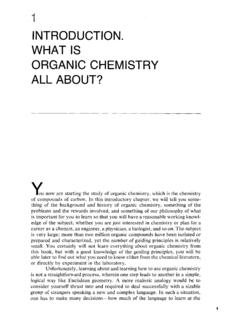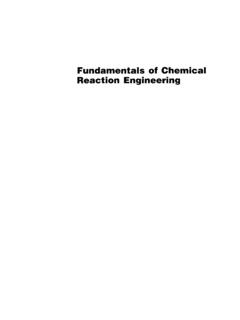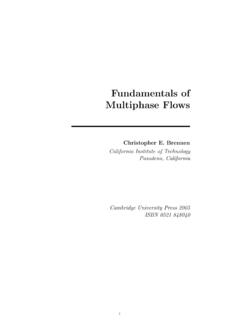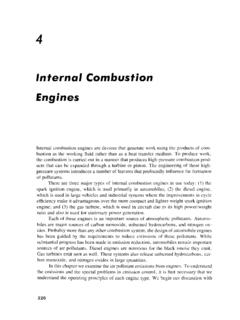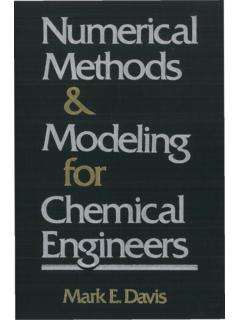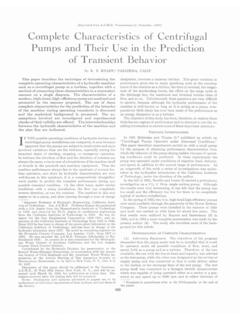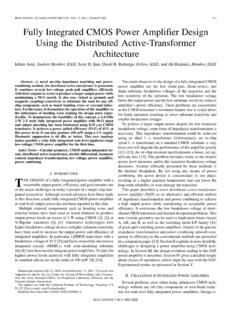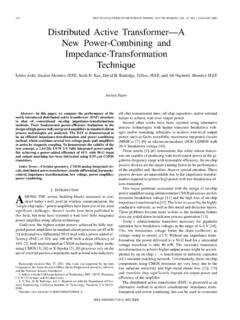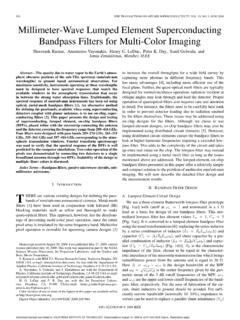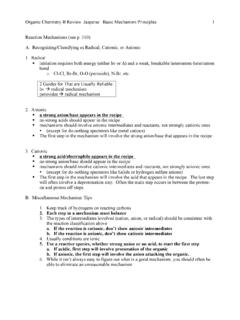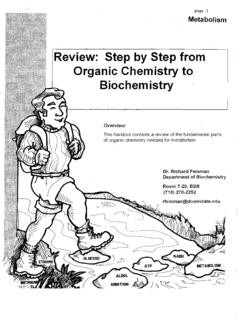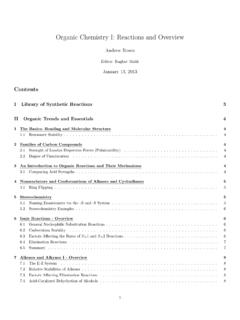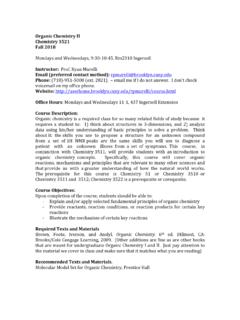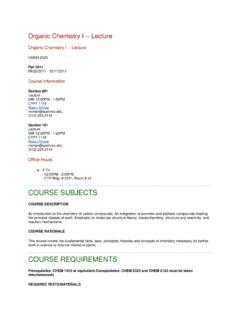Transcription of STRUCTURAL ORGANIC CHEMISTRY. THE SHAPES OF …
1 STRUCTURAL ORGANIC chemistry . THE SHAPES OF MOLECULES. FUNCTIONAL GROUPS I n this chapter we first briefly review the most important types of covalent bonds encountered in ORGANIC substances and the ways in which these bonds are represented in STRUCTURAL formulas. Next we consider the sizes and SHAPES of ORGANIC molecules and how STRUCTURAL formulas written in two dimensions can be translated into three-dimensional models that show the relative posi- tions of the atoms in space. We also discuss models that reflect the relative sizes of the atoms and the way in which the atoms may interfere with each other when in close quarters (steric hindrance). Then we go on to further im- portant aspects of structure-the functional group concept and position isomerism. Our aim is to have you become more familiar with the various kinds of ORGANIC compounds and begin to see how the practicing ORGANIC chemist visu- alizes molecules and correlates the diverse kinds of structures that he has to deal with in his work.
2 2-1 STRUCTURAL FORMULAS The building block of STRUCTURAL ORGANIC chemistry is the tetravalent carbon atom. With few exceptions, carbon compounds can be formulated with four 2-1 STRUCTURAL Fbrmulas 31 covalent bonds to each carbon, regardless of whether the combination is with carbon or some other element. The two-electron bond, which is illustrated by the carbon-hydrogen bonds in methane or ethane and the carbon-carbon bond in ethane, is called a single bond. In these and many related substances, each carbon is attached to four other atoms: H:C:H .. H:C:C:H .. H H H methane ethane There exist, however, compounds such as ethene (ethylene), C,H,, in which two electrons from each of the carbon atoms are mutually shared, thereby producing two two-electron bonds, an arrangement which is called a double bond. Each carbon in ethene is attached to only three other atoms: 5 .H .C : : ethene H' 'H Similarly, in ethyne (acetylene), C,H,, three electrons from each carbon atom are mutually shared, producing three two-electron bonds, called a triple bond, in which each carbon is attached to only two other atoms: H:C:::C:H ethyne Of course, in all cases each carbon has a full octet of electrons.
3 Carbon also forms double and triple bonds with several other elements that can exhibit a covalence of two or three. The carbon-oxygen (or carbonyl) double bond appears in carbon dioxide and many important ORGANIC compounds such as methanal (formaldehyde) and ethanoic acid (acetic acid). Similarly, a carbon- nitrogen triple bond appears in methanenitrile (hydrogen cyanide) and eth- anenitrile (acetonitrile). carbon dioxide rnethanal ethanoic acid (formaldehyde) (acetic acld) H H:c:::N: H:c:c:::N: .. H methanenitrile ethanenitr~le (hydrogen cyanide) (acetonitrlle) By convention, a single straight line connecting the atomic symbols is used to represent a single (two-electron) bond, two such lines to represent a 2 STRUCTURAL ORGANIC chemistry The SHAPES of Molecules Functional Groups double (four-electron) bond, and three lines a triple (six-electron) bond. Repre- sentations of compounds by these symbols are called STRUCTURAL formulas; some examples are H H I I H H-C-C-H \ /" f="\ H-CzC-H H-CzN I I H H H ' H ethane ethene ethyne methanenitrile (hydrogen cyanide) carbon dioxide methanal ethanoic acid ethanenitrile (formaldehyde) (acetic acid) (acetonitrile) A point worth noting is that STRUCTURAL formulas usually do not indicate the nonbonding electron pairs.
4 This is perhaps unfortunate because they play as much a part in the chemistry of ORGANIC molecules as do the bonding elec- trons and their omission may lead the unwary reader to overlook them. How- ever, when it is important to represent them, this can be done best with pairs of dots, although a few authors use lines: To save space and time in the representation of ORGANIC structures, it is common practice to use "condensed formulas" in which the bonds are not shown explicitly. In using condensed formulas, normal atomic valences are understood throughout. Examples of condensed formulas are CH3CH3 CH2CH, CHCH CH20 ethane ethene ethyne methanal (formaldehyde) CH3C0,H HCN CH3CN ethanoic acid methanenitrile ethanenitrile (acetic acid) (hydrogen cyanide) (acetonitrile) Another type of abbreviation that often is used, particularly for ring compounds, dispenses with the symbols for carbon and hydrogen atoms and leaves only the lines in a STRUCTURAL formula.
5 For instance, cyclopentane, C,H,,, often is represented as a regular pentagon in which it is understood that each apex represents a carbon atom with the requisite number of hydro- 2-1 STRUCTURAL Formulas gens to satisfy the tetravalence of carbon: cyclopentane Likewise, cyclopropane, C3H6; cyclobutane, C4H8; and cyclohexane, C6HI2, are drawn as regular polygons: cyclopropane cyclobutane cyclohexane Although this type of line drawing is employed most commonly for cyclic structures, its use for open chain (acyclic) structures is becoming increasingly widespread. There is no special merit to this abbreviation for simple struc- tures such as butane, C,H,,; 1-butene, C4H8; or 1,3-butadiene, C,H,, but it is of value in representing more complex molecules such as p-carotene, C4,H5,: /"../ butane M 1- butene 2 STRUCTURAL ORGANIC chemistry . The SHAPES of Molecules. Functional Groups Line structures also can be modified to represent the three-dimensional SHAPES of molecules, and the way that this is done will be discussed in detail in Chapter 5.
6 At the onset of your study of ORGANIC chemistry , you should write out the formulas rather completely until you are thoroughly familiar with what these abbreviations stand for. 2-2 THE SIZES AND SHAPES OF ORGANIC MOLECULES. MOLECULAR MODELS The size and shape of molecules are as much a part of molecular structure as is the order in which the component atoms are bonded. Contrary to the im- pression you may get from STRUCTURAL formulas, complex molecules are not flat and formless, but have well-defined spatial arrangements that are deter- mined by the lengths and directional character of their chemical bonds. It is not easy to visualize the possible arrangements of the bonds in space and it is very helpful to have some kind of mechanical model that reflects the molecular geometry, including at least an approximation to the relative lengths of the bonds. "Ball-and-stick" models such as the ones used by Paterno (Sec- tion 1-1D) fill this purpose admirably.
7 2-2A Bond Angles and Ball-and-Stick Models It is well established that the normal carbon atom forms its four single bonds in compounds of the type CX, so that the four attached atoms lie at the corners of a regular tetrahedron. The bond angles X-C-X are " and this value is the "normal" valence angle of carbon. For many purposes, ball-and-stick models of ORGANIC compounds give useful information about the spatial re- lationships of the atoms, and for CX, the angles between the sticks are set at " (Figure 2-1). ORGANIC molecules strongly resist deformation forces that alter their valence angles from normal values. Therefore ball-and-stick models correspond better to the behavior of actual molecules if the connectors repre- senting single bonds are made to be rather stiff. Figure 2-1 Ball-and-st~ck model of CX, 2-2A Bond Angles and Ball-and-St~ck Models ethene ethyne cyclopropane methanal Figure 2-2 Ball-and-stick models of some simple ORGANIC molecules Whereas methane, CH,, is tetrahedral, ethene, C,H,, is not.
8 According to the best available physical measurements, all six atoms of ethene lie in a single plane and the H-C-H bond angles are 1 ". Methanal (formalde- hyde) also is a planar molecule with an H-C-H bond angle of 118". Models of ethene and methanal can be built with ball-and-stick models by using flexible couplings or bent sticks to form the double bonds (Figure 2-2), but the H-C-H angles are inaccurate because they are " rather than the observed 117" to 118". Ethyne, C,H,, has been established experimentally to be a linear mole- cule; that is, the H-C-C bond angle is 180": eihyne H-C 36 2 STRUCTURAL ORGANIC Chem~stry The SHAPES of Molecules Funct~onal Groups This geometry also results with ball-and-stick models, if the triple bond is constructed of three flexible couplings or bent sticks as shown in Figure 2-2. STRUCTURAL units that have C-C-C valence angles substantially less than the tetrahedral value include double and triple bonds, and small rings such as cyclopropane.
9 Several bent bonds are required to construct models of com- pounds containing these units. Interestingly, such compounds are much less stable and more reactive than otherwise similar molecules for which models can be constructed with straight sticks at tetrahedral angles. 2-2B Bond Lengths and Space-Filling Models The length of a chemical bond is the average distance between the nuclei of two bonded atoms, regardless of where the bonding electrons happen to be. The customary unit of length is the angstrom1 (A = 10-lo m), and measure- ments often can be made with an accuracy of A by using the techniques of molecular spectroscopy, x-ray diffraction (for crystalline solids), and elec- tron diffraction (for volatile compounds). Bond lengths vary considerably with structure and depend on the identity of both atoms, the type of bonding (single, double, or triple), and the nature of other atoms or groups bonded to the two atoms in question. These effects are apparent in the data of Table 2-1, which lists the bond lengths in several simple ORGANIC compounds.
10 Multiple bonds, double or triple, clearly are shorter than single bonds, and it can be stated as a general observation that the more bonding electrons in a given bond, the shorter (and stronger) the bond. The lengths of single C-C bonds also vary significantly depending on what other atoms or groups are attached to the car- bons. Thus Table 2-1 shows that single C-C bonds become progressively shorter as the number of multiple bonds or electronegative atoms attached to the carbons increases. Although molecular models cannot represent the subtle variations in bond lengths and bond angles that actual molecules exhibit, most kinds of commercially available molecular models do attempt to reproduce relative bond lengths with some degree of reality. In the ball-and-stick type, the sticks usually come in various lengths to simulate different kinds of bonds; C-H bonds typically are scaled to represent A, C-C bonds to be A, and C=C and C=C to be correspondingly shorter.
